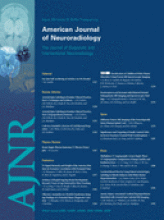Abstract
BACKGROUND AND PURPOSE: The occurrence of brain parenchymal signal-intensity changes within the drainage territory of developmental venous anomalies (DVAs) in the absence of cavernous malformations (CMs) has been incompletely assessed. This study was performed to evaluate the prevalence of brain parenchymal signal-intensity abnormalities subjacent to DVA, correlating with DVA morphology and location.
MATERIALS AND METHODS: One hundred sixty-four patients with brain MR imaging with contrast studies performed from July 2005 through June 2006 formed the study group. The examinations were reviewed and data were collected regarding the following: location, depth, size of draining vein, associated increased signal intensity on fluid-attenuated inversion recovery and T2-weighted images, associated CMs, and associated signal intensity on gradient recalled-echo sequences.
RESULTS: Of the 175 DVAs identified, 28 had associated signal-intensity abnormalities in the drainage territory. Seven of 28 DVAs with signal-intensity abnormalities were excluded because of significant adjacent white matter signal-intensity changes related to other pathology overlapping the drainage territory. Of the remaining DVAs imaged in this study, 21/168 (12.5%) had subjacent signal-intensity abnormalities. An adjusted prevalence rate of 9/115 (7.8%) was obtained by excluding patients with white matter disease more than minimal in degree. Periventricular location and older age were associated with DVA signal-intensity abnormality.
CONCLUSION: Signal-intensity abnormalities detectable by standard clinical MR images were identified in association with 12.5% of consecutively identified DVAs. Excluding patients with significant underlying white matter disease, we adjusted the prevalence to 7.8%. The etiology of the signal-intensity changes is unclear but may be related to edema, gliosis, or leukoaraiosis secondary to altered hemodynamics in the drainage area.
- Copyright © American Society of Neuroradiology












